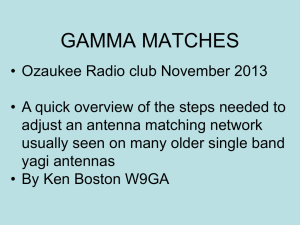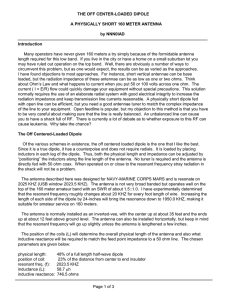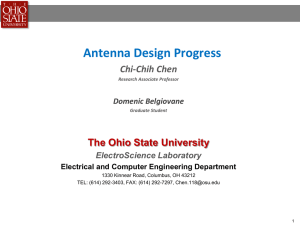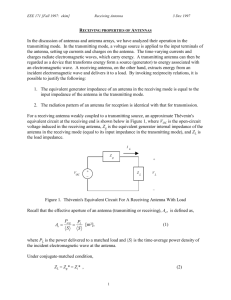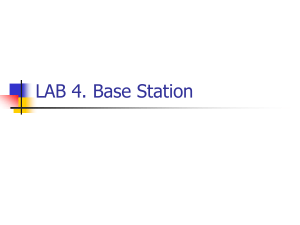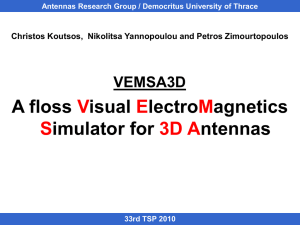Panel Antenna - Senior Design
advertisement
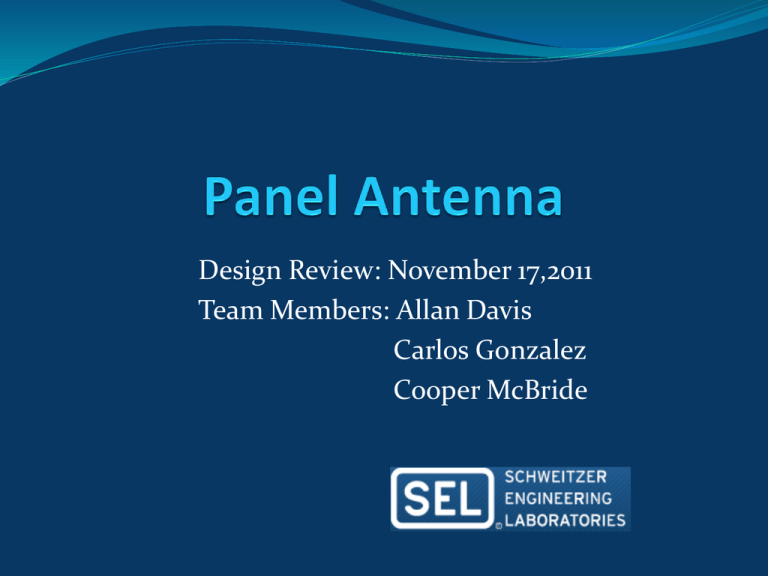
Design Review: November 17,2011 Team Members: Allan Davis Carlos Gonzalez Cooper McBride Objective Design, fabricate and test a 900-Mhz directional panel antenna for Schweitzer Engineering Laboratories 2 Applications Radios provide comm channels for electric utility protection, monitoring, and control Economical alternative to fiber-optic cable Backup primary protection channels 3 Other Uses Oil and gas pipelines and refineries Water and wastewater treatment facilities Fire and security alarm remote monitoring Many more possible applications of wireless communications for critical infrastructure 4 What SEL Needs An antenna that will have performance similar to a 5- element Yagi antenna The antenna will be used with the SEL-3031 transceiver 5 Why a Panel Antenna? SEL is currently selling directional Yagi antennas An example of a 5-element Yagi is shown here 6 This is a panel antenna made by the same company 7 Panel Antenna Pros: Lower cost than Yagi Compact package Ease of installation SEL can manufacture a panel antenna using existing facilities and equipment Panel Antenna Cons: Can’t increase directivity by adding elements as with Yagi More ways for material inconsistencies to affect performance 8 Specifications Directional Vertical or Horizontal Polarization Gain: ≥8 dBi HP Horizontal Beamwidth: 45° HP Vertical Beamwidth: 65° Operating Frequency Range: 900-930 MHz ~ 3% Bandwidth VSWR: ≤1.5:1 Characteristic Impedance: 50 Ω Designed Using Printed Circuit Board Technology 9 Example Radiation Patterns Dipole Yagi 10 Current Design - Bowtie This is a type of planar dipole antenna θ0 is called the opening angle 11 Bowtie Formulas Characteristic impedance* ZC = ln[cot(θ0 /4)] Length* L = 0.5 λ0 /(εeff)1/2 Effective dielectric constant* εeff = 0.5(εr + 1) + 0.5(εr – 1)(1 + 10 d/W)-0.555 We plan to use FR-4 substrate εr ~ 4.0-4.8 (decreases as frequency increases) d is typically 1.6 mm, but other thicknesses available *Source: C. Guo and R. Liu. (2009, June). A 900MHz shielded bow-tie antenna system for ground penetrating radar. [Online]. Available: http://ieeexplore.ieee.org/xpls/abs_all.jsp?arnumber=5550125&tag=1 12 Possible Design Options Edge cutting can be used to increase bandwidth of bowtie and decrease physical size 13 Another type of radiating element 14 Metal Patch antenna Gain not very high Not very robust 15 Design Challenges How much gain can we get? Feeding the antenna Impedance matching Determining spacing between PCB and backplate Correctly interpreting simulation results Simulation will require a lot of trial and error 16 Impedance Matching Want to match impedances to minimize transmission line reflections from antenna toward radio Max Power Transfer Low reflection coeff. Low VSWR This can be done both by changing antenna feed point and by designing microstrip feedline impedance to be Zmicrostrip = (ZcoaxZant)1/2 17 Validation Conduct impedance analysis using network analyzers in Applied EM Waves Lab. Time reserved for use of anechoic chamber at SEL Use to make antenna pattern measurements 900-MHz feed & measurement system available (antenna, signal generator, network analyzer, etc.) Most of our measurements will be focused on figures of merit, since SEL will have to have the antenna characterized before production 18 Software Agilent Advanced Design System (ADS) with Electromagnetic Professional (EMPro) SEL is planning to incorporateADS Design Suite for future projects FEM Simulator FDTD Simulator Method of Moments Impedance Analysis 19 Progress Currently a little behind according to our timeline Issue with EMPro software The software is unable to work correctly with standard Intel Graphic Chipsets Needed to order an Nvidia graphics card and install into a laboratory computer Works great now In the future we will want to upgrade the RAM from 2GB to 4GB 20 Working on getting tutorials to learn the software Need to wait for the University license instead of our trial version to obtain access to the tutorials Have put in our order for the University license 21 Budget EMPro Software - $2000 Nvidia GT 430 Graphics Card - $85 Kingston 2GB RAM - $25 N-Connectors - $4 Each PC Board and metal back plate Provided by SEL 22 Schedule 23 Questions? 24


